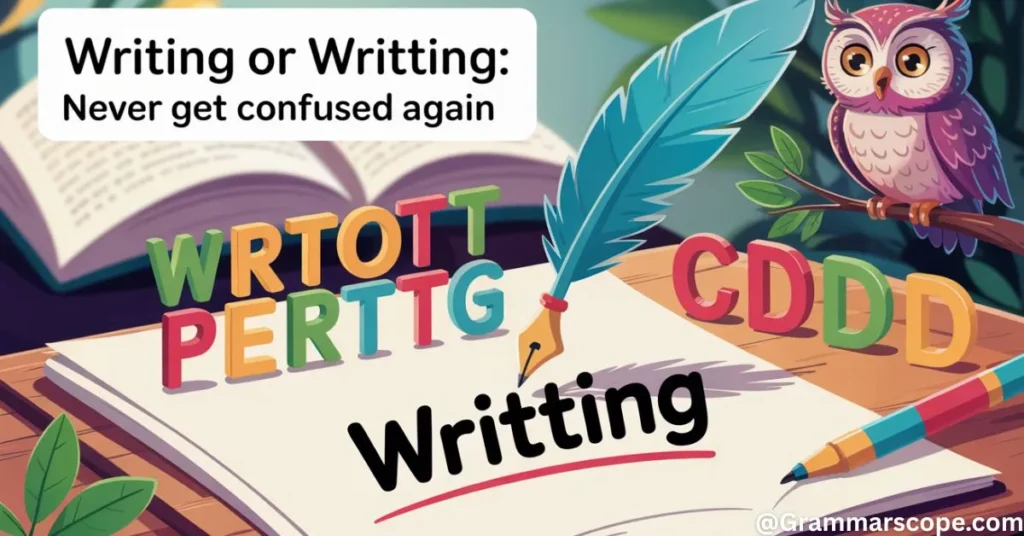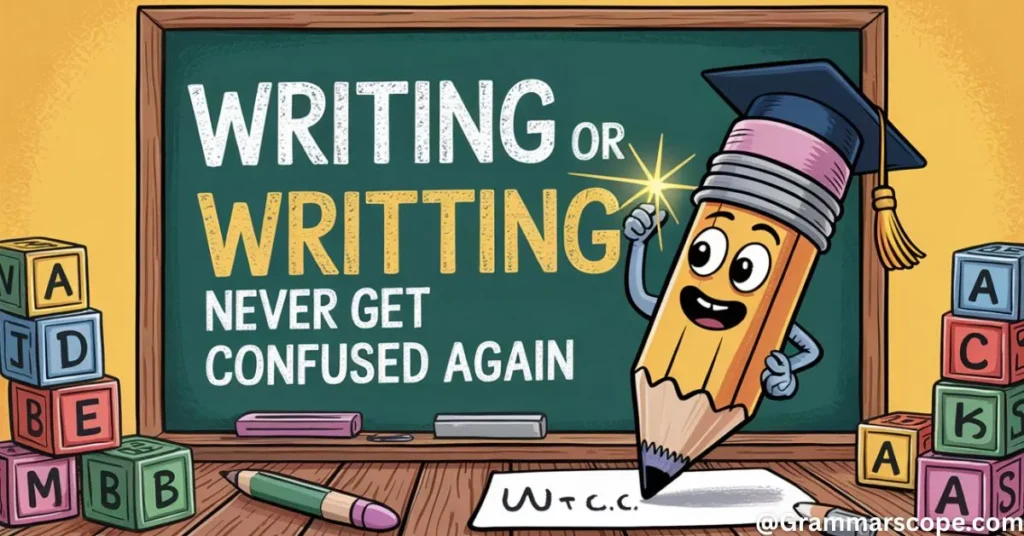Writing appears everywhere in our daily lives—from casual text messages to formal business documents. Yet, this seemingly simple word trips up countless English speakers and learners. The confusion between “writing” and “writting” has persisted for years, causing uncertainty in professional communications and everyday interactions alike. This common spelling error might seem trivial, but it can impact how others perceive your attention to detail and language proficiency.
The English language is notorious for its spelling inconsistencies. With rules full of exceptions and words borrowed from various linguistic traditions, even native speakers stumble occasionally. The “writing/writting” confusion represents one of those peculiar cases where intuition might lead you astray. One letter makes all the difference between correct usage and an error that might undermine your credibility in important situations.
Understanding the distinction isn’t just about memorizing a rule—it’s about grasping the patterns that govern English spelling. Once you recognize the underlying principle, you’ll never hesitate between these forms again. This guide will equip you with clear examples, memorable scenarios, and practical tips to ensure you always choose the correct spelling in any context, whether you’re drafting an important email, completing an academic assignment, or writing professional content.

Why The Confusion Exists
The confusion between “writing” and “writting” stems from several factors that make English spelling particularly challenging. First, English pronunciation doesn’t always clearly indicate spelling. When we say the word “writing,” the ‘t’ sound might seem emphasized enough to warrant doubling in the spelling—but this perception misleads many writers.
Additionally, English has numerous words where consonants are indeed doubled before adding the “-ing” suffix. Consider words like “swimming” (from swim), “running” (from run), and “beginning” (from begin). This pattern creates a reasonable assumption that “writing” might follow the same rule. However, understanding when to double consonants requires recognizing specific conditions that many writers haven’t formally learned.
The inconsistency of English grammar rules further complicates matters. The “silent e rule” dictates that for many words ending in ‘e’, we drop the ‘e’ before adding “-ing”—as in “write” becoming “writing.” Yet there are exceptions like “singeing” (to distinguish from “singing”) that preserve the ‘e’. These variations make it challenging to internalize a single, consistent approach.
“Writing” or “Writting”: Which is Correct?
Let’s settle this once and for all: “Writing” is the correct spelling. The word “writting” with two t’s is simply incorrect in standard English. This isn’t a matter of British versus American spelling variations—it’s universally recognized as a misspelling across all English-speaking regions.
The verb “write” follows the standard pattern for words ending in ‘e’: drop the ‘e’ and add “-ing” to form the present participle. This creates “writing”—with one ‘t’. The rule applies similarly to comparable words like “bite” (biting), “cite” (citing), and “site” (siting).
Understanding why “writing” is correct requires recognizing the role of the silent e rule in English. When a word ends with a consonant + silent ‘e’ pattern, we typically drop the ‘e’ before adding a suffix that begins with a vowel, like “-ing.” However, we don’t double the preceding consonant unless specific conditions are met—conditions that “write” doesn’t satisfy.
Common Scenarios Where This Mistake Occurs
Professional Emails
Email communication remains one of the most common contexts where the writing/writting error appears. Consider this example:
Dear Mr. Thompson,
I’m writing to follow up on our discussion from last week’s meeting. The team has been busy writing the proposal you requested, and we expect to deliver it by Friday. If you have any questions while we’re writing the final sections, please don’t hesitate to reach out.
Best regards, Sarah
Had Sarah used “writting” instead, it might have subtly undermined her professional image. In business contexts, correct spelling signals attention to detail and professionalism.
Academic Papers
Students frequently encounter this spelling challenge when writing academic assignments:
The process of writing a research paper requires careful attention to citation formats. Many students find that writing drafts helps organize their thoughts before finalizing their arguments. Effective academic writing demonstrates both critical thinking and clear communication skills.
Using “writting” in an academic context could affect grading and create a negative impression of the student’s writing skills.
Social Media Posts
Even in casual settings, spelling errors can distract from your message:
Just finished writing my first short story! So excited to share it with everyone next week. The process of writing fiction is so different from my usual technical writing work.
While social media users might be more forgiving of typos, consistent spelling errors can still influence how your communication is received.
Understanding the Rules of Consonant Doubling

To fully grasp why “writing” is correct while “writting” is not, you need to understand the principles that govern consonant doubling in English spelling.
The general rule for doubling consonants before adding “-ing” applies when all three of these conditions are met:
- The word ends in a single consonant
- This consonant is preceded by a single vowel
- The stress falls on the final syllable
Let’s analyze “write” against these criteria:
- It doesn’t end in a consonant (it ends in ‘e’)
- The ‘t’ is not preceded by a single vowel (it’s preceded by ‘i’, which is a vowel)
- The word has only one syllable, so the stress condition isn’t relevant
Since “write” doesn’t meet the necessary conditions, we don’t double the ‘t’ when adding “-ing”. We simply drop the silent ‘e’ and add “-ing” to form “writing”.
Words That Follow Similar Patterns
Understanding patterns helps reinforce proper spelling. Here are words that follow the same pattern as “writing”:
| Base Word | Present Participle | Rule Applied |
|---|---|---|
| write | writing | Drop ‘e’, add “-ing” |
| bite | biting | Drop ‘e’, add “-ing” |
| drive | driving | Drop ‘e’, add “-ing” |
| make | making | Drop ‘e’, add “-ing” |
| take | taking | Drop ‘e’, add “-ing” |
Conversely, here are examples where consonant doubling does occur:
| Base Word | Present Participle | Rule Applied |
|---|---|---|
| run | running | Double final consonant, add “-ing” |
| swim | swimming | Double final consonant, add “-ing” |
| begin | beginning | Double final consonant, add “-ing” |
| sit | sitting | Double final consonant, add “-ing” |
| plan | planning | Double final consonant, add “-ing” |
Recognizing these patterns can improve your overall language learning and help prevent similar spelling mistakes.
Real-Life Impact of This Common Mistake
Common mistakes like confusing “writing” and “writting” can have tangible consequences. Consider these scenarios:
Job Applications
Emma applied for a content writing position and submitted a cover letter containing “writting” multiple times. Despite her excellent qualifications, the hiring manager questioned her attention to detail and writing ability, ultimately choosing another candidate.
Client Communications
Jason, a freelance designer, sent a proposal to a potential client containing the line: “I’m writting to propose my services for your upcoming project.” The client noticed the error and wondered about Jason’s professionalism, creating an unnecessary hurdle in building trust.
Educational Settings
A student received feedback on an essay: “Your arguments are strong, but multiple instances of ‘writting’ suggest carelessness. Please proofread more carefully next time.”
These examples highlight how this seemingly minor spelling issue can influence important outcomes.
Pro Tips for Remembering the Correct Spelling
The most critical paragraph in this article is the explanation of consonant doubling rules, as it provides the fundamental understanding needed to avoid this mistake. Here are some pro tips to help you remember:
- Visualize the transformation: Write → Drop ‘e’ → Writ → Add ‘ing’ → Writing
- Create a memory aid: Remember “One T for Writing” as a simple mnemonic device.
- Use word families: Group “write/writing” with similar words like “bite/biting” and “site/siting” to reinforce the pattern.
- Practice deliberate correction: If you catch yourself typing “writting,” immediately correct it and say the proper form aloud to strengthen neural pathways.
- Use technology wisely: Set up autocorrect on your devices to flag “writting” as a misspelled word, but don’t rely solely on technology—understand the rule.
Etymology and History of “Write”

The word formation history of “write” helps explain its modern spelling. The word derives from Old English “wrītan,” meaning to scratch, draw, or inscribe. This Germanic root evolved through Middle English (“writen”) before reaching its current form.
Understanding etymology reveals why “write” ends with a silent ‘e’ in the first place. The ‘e’ originally represented a vowel that was pronounced in earlier forms of English but gradually fell silent as pronunciation evolved. However, it remains in the spelling to indicate the long ‘i’ sound in “write.”
This historical perspective shows that “writing” with one ‘t’ isn’t arbitrary but reflects the word’s linguistic evolution through centuries of English grammar development.
Common Expressions Using “Writing”
Familiarizing yourself with common phrases can reinforce correct usage:
- Writing between the lines (understanding what’s implied but not explicitly stated)
- Creative writing
- Technical writing
- Writing off (a financial or accounting term)
- Handwriting
- Writing on the wall (a sign of something inevitable)
Using these expressions regularly helps cement the correct spelling in your mind.
Digital Age Challenges: Autocorrect and Spelling
In today’s digital environment, we face unique challenges with spelling. While autocorrect can catch common typos like “writting,” overreliance on these tools can weaken our fundamental understanding of spelling rules.
Many people now write primarily using devices with spelling assistance, which can mask underlying knowledge gaps. When these tools aren’t available—perhaps when using unfamiliar software or writing by hand—previously hidden spelling difficulties suddenly emerge.
The solution isn’t avoiding technology but using it as a complement to solid spelling knowledge. Understanding rules like those governing “writing” vs. “writting” provides a foundation that technology can enhance rather than replace.
International English Perspectives
While American spelling and British spelling differ on many words (color/colour, center/centre), “writing” is spelled identically worldwide. This consistency across variants of English underscores that “writting” is universally incorrect.
English language learners often struggle with these distinctions, especially when their native language follows different patterns for forming continuous verbs. For example, speakers of languages with more phonetic spelling systems might naturally assume that the pronounced ‘t’ sound should be represented by doubling the letter.
Understanding that “writing” is correct in all forms of standardized English simplifies the learning process and prevents confusion when consuming content from different English-speaking regions.
Frequently Asked Question
Is writing correct or not?
Yes, “writing” is the correct spelling. “Writting” with two t’s is incorrect in standard English.
The correct spelling follows the rule for words ending in ‘e’: drop the ‘e’ and add “-ing” to form the present participle. This gives us “writing” with just one ‘t’.
Is it writen or written?
Written is the correct spelling.
“Written” is the past participle form of the verb “write.” The spelling “writen” with one ‘t’ is incorrect in standard English.
This follows a different pattern than the “-ing” form we just discussed. For the past participle of “write,” we double the ‘t’ to form “written.”
Is it normal to mix up letters when writing?
Yes, it’s quite normal to mix up letters when writing. This happens to many people for various reasons:
- Speed – When writing quickly, your brain can work faster than your hands, causing letter mixups.
- Fatigue – Being tired can increase the likelihood of transposing or missing letters.
- Dyslexia – For some people, letter reversals and mixups are related to dyslexia or other learning differences.
- Distraction – When your attention is divided, errors become more common.
- Typing vs. handwriting – Different mechanical processes can lead to different types of errors.
These mixups are usually just simple mistakes rather than signs of a problem. Even professional writers and editors make these errors, which is why proofreading is so important. If you find you’re consistently mixing up specific letters or patterns, it might be worth paying extra attention to those particular combinations when reviewing your work.
If letter mixups are frequent and causing significant problems, particularly in children learning to write, it could be worth discussing with an education professional or healthcare provider to rule out any underlying issues.
How do you spell writing as in writing a letter?
The correct spelling is “writing” with one ‘t’.
When referring to the act of writing a letter, composing text, or any other form of written communication, the proper spelling is “writing” (w-r-i-t-i-n-g).
This follows the spelling rule where you drop the ‘e’ from the base word “write” when adding the “-ing” ending. The ‘t’ is not doubled in this case.
Do we say writing or writting?
We say “writing” with one ‘t’.
“Writing” is the correct form, both in pronunciation and spelling. “Writting” with two t’s is incorrect and not used in standard English.
The word follows the rule for verbs ending in ‘e’: we drop the ‘e’ and add “-ing” without doubling the preceding consonant. So “write” becomes “writing,” just as “bite” becomes “biting” and “make” becomes “making.”
Conclusion: Mastering Writing vs. Writting
The distinction between “writing” and “writting” represents more than just a spelling detail—it reflects a pattern that applies to numerous English words. By understanding the underlying rules of verb endings and silent ‘e’ words, you’ve gained knowledge that extends beyond this specific example.
Remember these key takeaways:
- “Writing” (with one ‘t’) is always correct
- “Writting” (with two ‘t’s) is always incorrect
- Words ending in silent ‘e’ drop the ‘e’ before adding “-ing”
- Consonant doubling follows specific rules that “write” doesn’t meet
This knowledge will serve you well across all written communication, from casual texts to formal documents. The next time you hesitate between “writing” and “writting,” you’ll confidently choose the correct form, knowing exactly why it’s right.
With practice, correct spelling becomes automatic. Each time you use “writing” properly, you strengthen neural pathways that make good spelling habitual rather than effortful. Like many aspects of language mastery, what seems challenging at first eventually becomes second nature through understanding and application.

Emma Olivia is an experienced blogger and the creative mind behind Grammar Scope. With a passion for language and years of writing expertise, she crafts engaging, informative content that simplifies grammar and writing tips for readers worldwide. Emma’s dedication to clear communication and love for the written word shine through every article she publishes, making Grammar Scope a trusted resource for language enthusiasts and learners alike.






